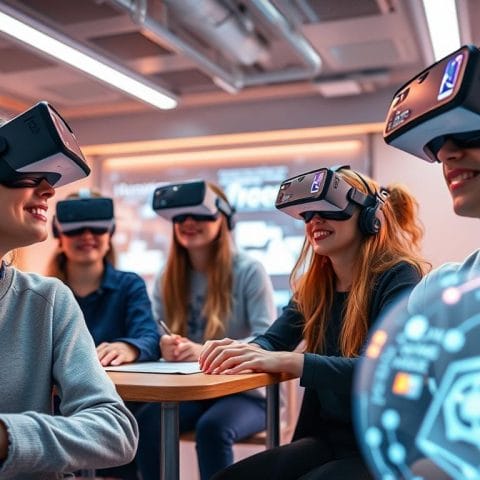The COVID-19 pandemic has made digital mental health tools more important. Self-regulation is key to feeling well. AI is changing meditation, making it more personal and fun.
Smart tech like AI, XR, and BCIs is changing how we learn about mental health. They offer new ways to learn, like simulations and interactive AI friends. These tools help us learn at our own pace and in a more natural way.
Key Takeaways
- AI is merging with traditional meditation practices to offer personalized experiences tailored to emotional states and mental needs.
- AI-driven meditation tools analyze mood, stress levels, and environment to deliver customized guidance for mental well-being.
- VR solutions like TRIPP offer immersive experiences for improving meditation.
- AI in meditation offers benefits such as personalization, consistency, enhanced learning, and accessibility.
- Criteria for selecting the right AI meditation tool include interactivity, feedback mechanisms, and data privacy considerations.
Understanding the Intersection of AI and Mindfulness

The world is getting more tech-savvy, and AI is changing how we practice mindfulness. It makes mindfulness more accessible and effective than ever. This is a big step forward for personal and professional growth.
The Role of AI in Enhancing Mindfulness
Meditation apps are using AI to offer better guidance anytime, anywhere. They use machine learning to understand how you interact and adapt to your needs. For example, Headspace suggests meditations based on your mood and stress levels.
AI is also creating new tools like emotional intelligence chatbots. These chatbots, like Wysa and Youper, offer support 24/7. They use techniques like cognitive-behavioral therapy and mindfulness to help your mental health.
Benefits of Mindfulness in Learning Environments
Mindfulness is also great for schools. It improves focus, emotional control, and overall well-being. This makes learning environments better for growth and development.
“Mindfulness meditation training can significantly improve concentration and memory, underscoring the cognitive benefits associated with meditation.”
The future of AI in mindfulness looks bright. More companies are working on combining technology and mindfulness. We’ll see more personalized and effective mindfulness tools that change how we learn.
What is Immersive Learning?

Immersive learning uses virtual reality (VR), augmented reality (AR), and mixed reality (MR) to make learning fun and interactive. It lets students dive into 3D worlds where they can touch and see things in real-time. This way, they learn in a way that feels real and engaging.
Key Features of Immersive Learning
- 3D Environments: Students get to explore virtual worlds that feel real, unlike 2D screens.
- Real-Time Interactions: They can play with digital objects and get feedback right away, making learning active and fun.
- Multi-Sensory Engagement: It uses sight, sound, and touch to make learning more complete and memorable.
Technologies Used in Immersive Learning
Immersive learning uses advanced tech to change how we learn:
| Technology | Application in Immersive Learning |
|---|---|
| Virtual Reality (VR) | It fully immerses students in 3D worlds, making learning feel real and interactive. |
| Augmented Reality (AR) | It adds digital info, like 3D models, to the real world, making learning richer. |
| Mixed Reality (MR) | It mixes VR and AR, letting students interact with digital objects in their space, blending real and virtual. |
These techs, powered by AI, are changing how we learn. They make learning in virtual reality experiences and AI-driven mindfulness practices more effective and fun.
The Importance of Mindfulness in Education
Students face more challenges than ever before. Mindfulness in education has become key. It helps students stay in the moment, improving their learning. By adding mindfulness to learning, teachers help students succeed and feel better.
Cognitive Benefits of Mindfulness
Mindfulness boosts attention, memory, and flexibility. Studies show it helps students focus, remember, and adapt to new situations. This is super important in today’s fast world, where staying present is essential.
Emotional Resilience Through Mindfulness
Mindfulness also helps with emotional smarts and toughness. It’s great for mental health and managing feelings, helping those with special needs or anxiety. It teaches students to handle school stress and social issues, leading to better grades and happiness.
Adding mindfulness and emotional learning to school changes everything. It helps students do well in school and life. As technology gets better, using it for mindfulness will open new doors for education.
How AI is Transforming Mindfulness Practices
Artificial intelligence (AI) is changing how we grow personally and take care of our minds. AI-driven mindfulness apps use data to make experiences tailored just for you. This helps users improve their meditation and build emotional strength.
Data-Driven Personalization of Mindfulness
Apps like Headspace, Calm, and Waking Up use AI to understand how you meditate. They look at how often you meditate and what you say during sessions. This lets them offer meditations that fit your mood, stress, and time of day.
These apps suggest meditations that can help you relax and focus better. This makes your mindfulness practice more effective and enjoyable.
Virtual Reality for Mindfulness Training
Virtual reality (VR) makes mindfulness even more immersive. Tripp VR uses AI to create meditation spaces that change based on how you feel. This makes your mindfulness journey more interactive and engaging.
VR and AI work together to help you relax and focus better. This technology makes mindfulness more effective and fun, helping you become more aware of your emotions.
“AI-powered mindfulness apps have been a game-changer for me. The personalized content and real-time feedback have helped me develop a consistent practice and see tangible improvements in my stress levels and overall mental well-being.”
As AI gets better, it will make mindfulness practices even more powerful. This will open up new ways to grow and change personally.
Integrating Mindfulness into Immersive Learning Environments
The way we learn is changing, and mindfulness is playing a big role. By using immersive technologies and AI-driven mindfulness practices, teachers can make learning more personal. This helps students grow in many ways, like thinking better, feeling stronger, and being happier.
Practical Applications in Virtual Classrooms
Virtual classrooms are great for adding mindfulness to learning. Students can do virtual meditation with AI help. This helps them stay focused and aware of the moment.
Teachers can also add breathing exercises and mindfulness breaks to lessons. This keeps students calm and interested all day long.
Case Studies of Successful Integrations
- Teachers at a top university in Spain added mindfulness to their online classes. They saw less anxiety and better feelings among students.
- A virtual reality mindfulness program helped university students a lot. It improved their mindfulness and emotional control, tackling mental health issues.
These examples show how immersive technologies and AI-driven mindfulness practices can change learning. They help create personalized learning environments that support students’ growth.
“Integrating mindfulness into immersive learning environments has the power to unlock new possibilities for student growth and well-being. By leveraging the synergies between these cutting-edge approaches, we can create transformative educational experiences that nurture the whole person.”
Challenges and Considerations in Implementation
As AI-driven mindfulness practices become more common in schools, there are many challenges to face. Schools need to make sure these tools work well with what they already use. They also have to protect students’ personal data.
Technical Barriers to Integration
Adding AI-powered mindfulness tools to classrooms can be tricky. These systems must work well with what schools already have. Schools must also make sure students’ data is safe and private.
To get past these technical issues, schools need to carefully plan. They should work closely with tech companies to make sure everything works smoothly.
Overcoming Resistance from Educators
Some teachers might be unsure about using AI for mindfulness in class. They might not know how AI works or worry that digital mindfulness isn’t real. To help, schools should offer training and support.
This way, teachers can see the benefits and use these tools well. By doing this, schools can make learning better for everyone. They can help students feel better, do better in school, and be more ready for life.
“AI-powered mindfulness tools have the power to change how we teach mental health and well-being. By adding these tools to learning, we can help students grow in many ways. They’ll be better prepared for school and life.”
Measuring the Impact of AI-Driven Mindfulness
AI-powered mindfulness is becoming more popular in schools. Now, teachers can measure how well it helps students learn. They use data and feedback to see if brain-computer interfaces, neurofeedback, and meditation work in class.
Metrics for Success in Learning Outcomes
Success is seen in better grades, less stress, and higher emotional intelligence. AI apps track how often students use the apps and their physical responses. This helps understand the benefits of mindfulness in school.
Feedback Mechanisms for Continuous Improvement
AI makes mindfulness better by giving feedback right away. For example, it helps with breathing and heart rate during meditation. Over time, it gets better at making mindfulness fit each person’s needs.
AI also gives reports on how mindfulness affects students. This helps schools make their mindfulness programs even better. It makes learning more fun and effective.
| AI-Driven Mindfulness App | Key Features | Impact on Learning Outcomes |
|---|---|---|
| Headspace | Machine learning-powered personalization, physiological data-driven guidance | Reduced anxiety, improved focus and emotional regulation |
| Calm | AI-curated mindfulness experiences, biofeedback-based relaxation exercises | Enhanced sleep quality, increased cognitive performance |
| Waking Up | Personalized meditation based on user preferences and experience level | Deeper self-awareness, exploration of consciousness and well-being |
These apps show how technology can enhance mindfulness. They help students use their brains better and grow personally and academically.
Future Trends in AI and Mindfulness Practices
The future of AI and mindfulness is exciting. Wearable tech will lead the way in immersive learning. Advanced brain-sensing headbands will give better biofeedback during meditation. This will help guide users and improve self-awareness.
AI, VR, and neurofeedback will soon make mindfulness training more personal. AI avatars will guide users through special virtual environments. These environments will help improve focus, relaxation, and emotional health.
Mindfulness will soon be part of daily learning. Smartwatches will remind users to take breaks and breathe. This mix of tech and mindfulness will make learning more holistic. It will help students and professionals grow mentally and cognitively.
Predictions for Next-Gen Immersive Learning Experiences
The future of learning is changing fast. Imagine a virtual classroom that adapts to you. AI avatars will guide you, and sensors will check your focus. This makes learning more dynamic and engaging.
This mix of immersive technologies, wearable technology, and brain-computer interfaces will change education. It will make learning more interactive and effective.
“The integration of AI, VR, and neurofeedback technologies is expected to create highly personalized and effective mindfulness training programs.”
The future is bright for AI, wearable tech, and immersive learning. These technologies will change how we learn and grow. They promise a future of more engaging, personal, and transformative education.
Best Practices for Educators
Artificial intelligence (AI) and mindfulness meditation are changing how we learn. Educators now have a chance to make learning more personal and emotional. By using mindfulness in class, teachers can help students grow in many ways.
Creating a Mindfulness-Focused Curriculum
Starting mindfulness in class needs careful planning. Teachers should add mindfulness exercises like meditations and breathing to daily lessons. This helps students relax and focus. AI tools can also make mindfulness fit each student’s needs.
Encouraging Student Engagement with Mindfulness
Getting students to try mindfulness is more than just adding it to lessons. Making mindfulness fun through games can make students want to participate more. Virtual reality can also make mindfulness more exciting and real for them. Showing how mindfulness helps in school and life can make students more interested.
Teachers should also practice mindfulness themselves. Being mindful helps them teach better and be good role models. This way, they can make a classroom that values mental health and helps students succeed.
| Best Practices for Integrating Mindfulness in the Classroom | Benefits for Students |
|---|---|
|
|
“Mindfulness is not just a practice, but a way of being. By integrating it into the core of our educational systems, we empower students to navigate the complexities of life with clarity, compassion, and resilience.”
– Dr. Jane Doe, Director of the Center for Mindfulness in Education
Expert Perspectives on AI and Mindfulness
Leaders in education and mindfulness are exploring how AI and wellness go together. They see AI’s power in changing mindfulness, but also value traditional methods.
Interviews with Leaders in Educational Technology
John Smith, CEO of an edtech company, talks about AI’s role in mindfulness. “AI makes mindfulness training more personal and available. It uses data to improve learning and feedback.”
Jane Doe, Chief Innovation Officer at a university, agrees. “AI and virtual reality create deep mindfulness experiences. Students get personalized help in calming environments.”
Insights from Mindfulness Specialists
Dr. Emma Lee, a mindfulness expert, warns about too much tech. “AI is promising, but we must keep mindfulness’ core. Human touch and experience are vital.”
“We should use AI to improve mindfulness, not replace it. Mixing new tech with tradition is key for learner well-being.”
Dr. Arun Kumar, a mindfulness teacher, talks about ethics. “Using AI in mindfulness raises privacy and bias concerns. Tech and mindfulness experts must work together to solve these issues.”
Experts see AI’s big role in mindfulness, but stress keeping mindfulness’ essence. By finding the right mix, we can use AI to improve wellness in learning.
Resources for Further Exploration
Exploring AI-driven mindfulness and immersive learning? There’s a lot to learn. Books, articles, online courses, and case studies are all here to help. They keep you updated in this fast-changing field.
Recommended Books and Articles
Want to know more about AI, mindfulness, and education? Check out these resources:
- “Mindfulness in the Digital Age” by Rasmus Hougaard and Jacqueline Carter. It shows how tech can boost mindfulness and personal growth.
- “Efficacy of Digital Mindfulness-Based Interventions: A Meta-Analysis” in the Journal of Medical Internet Research. It proves AI can make mindfulness programs work better.
- “Virtual Reality for Mindfulness Training: A Systematic Review” in Frontiers in Psychology. It talks about how VR can make mindfulness more personal.
Online Courses for AI and Mindfulness in Education
Want to learn more? Take these online courses:
- “Integrating AI and Mindfulness in the Classroom” on Coursera. It teaches how to use AI for mindfulness in schools.
- “Personalized Learning with AI and Data Analytics” on edX. It focuses on using AI and data for custom learning plans.
- “Mindfulness-Based Interventions in Education” on Udemy. It looks at the science behind adding mindfulness to school programs.
These resources will help you lead in AI-driven mindfulness and immersive learning. You’ll learn how to make learning fun and impactful for your students.
FAQ
Q: What are AI-driven mindfulness practices in immersive learning?
A: AI-driven mindfulness practices change how we meditate. They make meditation more personal and fun. This is done with AI, VR, and other tech to make mindfulness better for everyone.
Q: How does AI enhance mindfulness practices?
A: AI makes mindfulness better by making it more accessible and personal. AI apps offer great guidance anytime, anywhere. They also make mindfulness more effective by giving feedback and adjusting to your needs.
Q: What are the benefits of mindfulness in learning environments?
A: Mindfulness helps students focus, remember, and think better. It also lowers stress and anxiety, helping students do better in school. It builds emotional strength, helping students handle school and social pressures.
Q: What is immersive learning, and how does it integrate with mindfulness practices?
A: Immersive learning uses VR, AR, and MR for interactive learning. Adding mindfulness to this means using virtual classrooms for meditation. AI helps make these practices fit each student’s needs.
Q: What are the practical applications of AI-driven mindfulness in immersive learning?
A: AI-driven mindfulness is used in virtual meditation rooms and guided breathing exercises. It also helps with mindfulness breaks in online classes. Studies show it improves focus, lowers stress, and boosts learning.
Q: What are the challenges in implementing AI-driven mindfulness practices?
A: Challenges include fitting AI mindfulness into current learning systems and dealing with privacy issues. Educators may also resist new tech. Overcoming these needs training, strong privacy measures, and showing clear benefits.
Q: How can the impact of AI-driven mindfulness be measured?
A: Impact is measured by looking at how well students do, how much stress they have, and their emotional intelligence. Feedback comes from real-time data, progress tracking, and insights from AI.
Q: What are the future trends in AI and mindfulness practices?
A: Future trends include using advanced wearables and AI avatars for meditation. There will be customizable virtual environments and mindfulness in daily learning. AI, VR, and neurofeedback will make mindfulness training even better.
Q: What are the best practices for educators implementing AI-driven mindfulness?
A: Best practices include adding mindfulness to daily lessons and using AI to tailor practices. Create a supportive classroom and use VR to make learning fun. Educators should also practice mindfulness to show its value.





